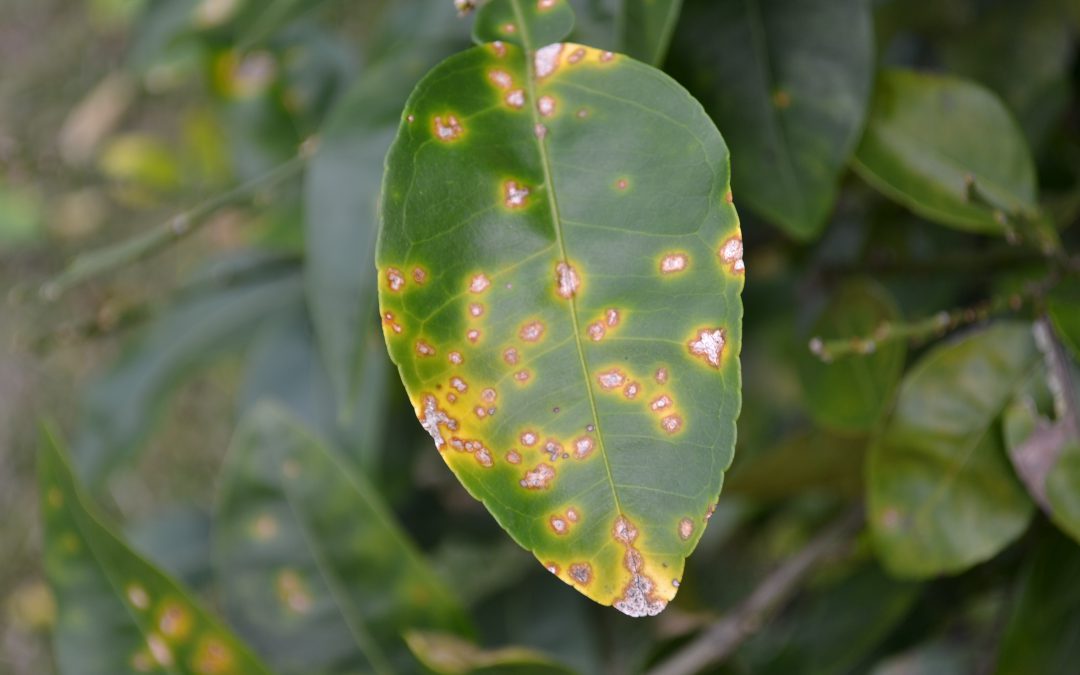
by Beth Bolles | Jul 14, 2022
Citrus canker has made its way to Escambia County and may be more widespread that we realize. This bacterial disease was first seen in Northwest Florida almost 10 years ago in Gulf Breeze. Given time and the ease of transmission of this disease, we are now seeing affected citrus trees in both the east and west portions of Escambia County.
This disease is specific to citrus with grapefruit, lemon, and lime being the most susceptible to infection. The disease can infect all above ground tissues and often enters through natural openings and wounds of leaves, stems, and fruit. If you find an infection early in an isolated area of the tree, you can prune out and double bag the affected tissue for disposal. Often times, the disease is noticed only after a considerable amount of tissue and fruit are affected making it difficult to keep the disease in check.
Since the bacteria is so easily transmitted through rain and wind, it is difficult to prevent movement during our frequent storm events. People can also spread the disease by movement of unregulated citrus trees, on equipment, and even on clothing.
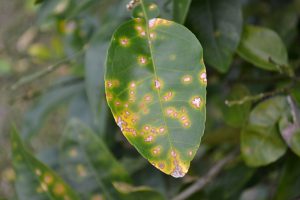
Citrus canker lesions appear on both the upper and lower surfaces of the leaves. Photo by Beth Bolles, UF IFAS Extension Escambia County
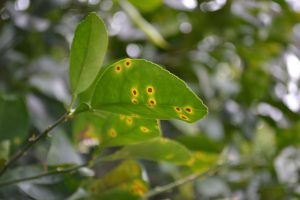
Lower surface with citrus canker. Photo by Beth Bolles, UF IFAS Extension Escambia County
If you suspect a citrus in your landscape has canker, do not bring a sample to your Extension office for identification. Take a photo of plant symptoms of upper and lower leaves, fruits, and stems so that your local Extension educators can assist with identification. The University of Florida publication https://edis.ifas.ufl.edu/publication/PP323 has quality photos and descriptions of the different stages of citrus canker, along with photos of other citrus issues.
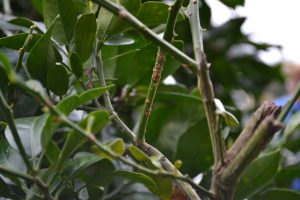
Stem lesions on grapefruit. Photo by Beth Bolles, UF IFAS Extension Escambia County.
The bad new for homeowners is that there is not a treatment to cure citrus canker. If the infection is small (a few leaves or a branch), it may be possible to remove and dispose of the material, following proper sanitation guidelines. Homeowners may also suppress a small infection on fruit by using copper-based fungicides, applied at appropriate intervals. These fungicides only protect plant tissue for a short time by acting as a barrier to infection. See this UF publication for timing of copper sprays for fruit.
Once susceptible citrus are heavily infected, trees will have fruit and leaf drop, along with general decline and dieback. At this stage of the disease, homeowners should strongly consider removing the tree. If it can be burned on site in accordance with local burn laws, that keeps the material contained and may reduce disease transmission. Otherwise, all material should be double bagged and sent to a landfill. Do not compost any material onsite or at local composting facilities. Be sure to follow disinfecting techniques outlined in the University of Florida publication https://edis.ifas.ufl.edu/publication/PP323 for tools, hands, and clothing.
Since management of citrus canker is so difficult, prevention is the best method to protect your tree. If you are considering a citrus, choose a more resistant selection outlined in the UF publication, Table 2. Always purchase a citrus from a certified nursery and follow state guidelines which prohibits all propagation of citrus, unless registered to do so.
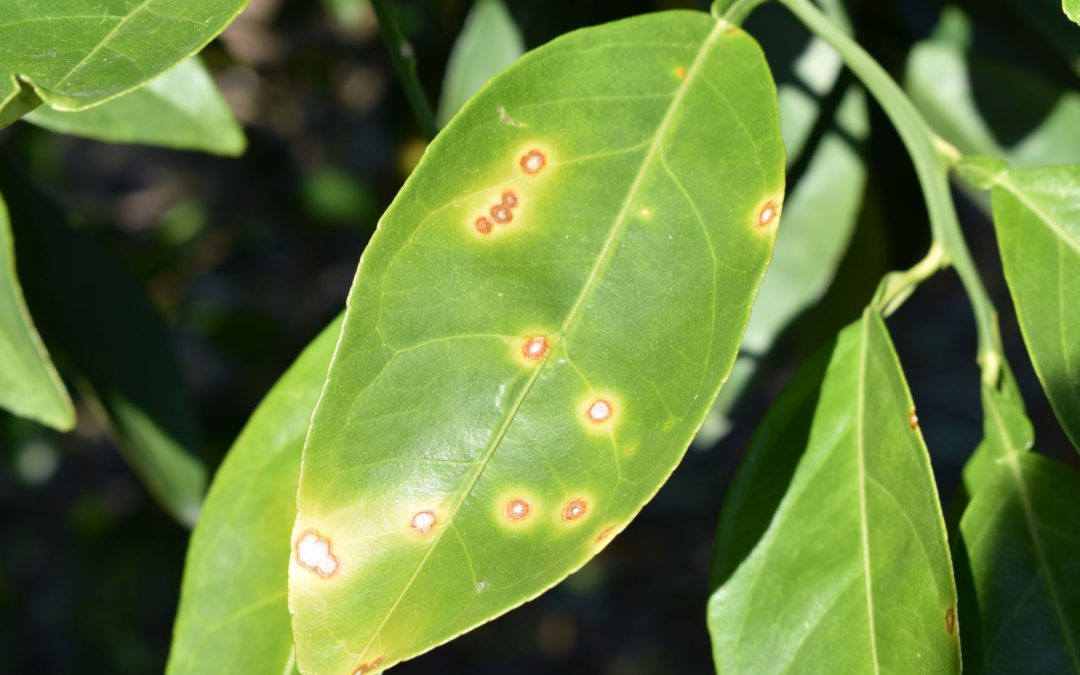
by Mary Salinas | Apr 1, 2021
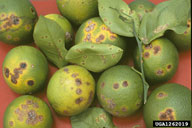
Citrus canker symptoms on twigs, leaves and fruit. Photo by Timothy Schubert, FDACS
Citrus canker was found for the first time in the Florida panhandle in Gulf Breeze in southern Santa Rosa County in November 2013. Since that time, citrus canker has spread widely in the Gulf Breeze area and just recently in 2020 was found in two locations in Panama City and Panama City Beach in Bay County.
Citrus canker is a serious bacterial disease that only infects citrus trees. It will not infect any other plant species nor is it a threat to human health. Severely affected trees experience substantial leaf loss and premature fruit drop and serve as a source for infecting nearby citrus. The disease spreads through wind, rain, and transportation of infected plant material from other locations.
This highly contagious disease has no cure although progression of the disease can be slowed through the use of copper-based products. This publication guides the homeowner on using copper.
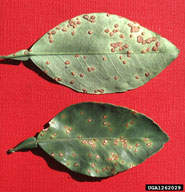
Citrus canker lesions on leaves are raised, rough and visible on both sides of the leaf. Photo by Timothy Shubert, FDACS.
Not all citrus varieties are equally susceptible to this disease. Grapefruit, lemon, and lime are some of the most vulnerable while tangerine and tangelo varieties are among the most resistant.
What should you do if you suspect your citrus is infected with this disease?
- Look at this guide for more information and compare the symptoms on your tree to the photos. Lesions on the leaves penetrate through the leaf so they are visible on the upper and lower leaf surfaces, are rough, and have a yellow halo. The lesions look similar on the fruit and stems. Lesions (or cankers) on the stems usually indicate a longer standing infection of a year or more.
- Consult your local Horticulture Extension Agent to confirm the diagnosis and obtain more information and control/removal strategies.
- Proper removal of infected trees is recommended to prevent the spread of citrus canker but is not mandatory. The best way to dispose of infected trees is through cutting them down and burning them onsite; this ensures than none of the plant material leaves your yard to infect other areas. Consult your local burn regulations before burning. Stray leaves, branches and fruit should be raked and burned or double bagged for the trash. Please avoid disposing of any of your citrus trees by putting them by the side of the road for pickup by the county yard waste recycling or regular waste disposal. The bacterium will survive in the plant tissue and be spread to other neighborhoods in the county. You can, however, double bag infected plant material in sturdy bags and place it in the trash.
For more information please see:
UF IFAS Gardening Solutions: Citrus
Citrus Culture in the Home Landscape
UF IFAS Extension Online Guide to Citrus Diseases

by Mary Salinas | May 11, 2017

Citrus canker symptoms on twigs, leaves and fruit. Photo by Timothy Schubert, FDACS
In November 2013, citrus canker was found for the first time in the Florida panhandle in Gulf Breeze in southern Santa Rosa County. The Florida Department of Agriculture and Consumer Services (FDACS) tested and confirmed the disease on grapefruit trees in a residential landscape. Since that time, citrus canker has been confirmed on citrus trees at 27 more locations in Gulf Breeze. To my knowledge it has not been found in any other location in the panhandle. Not yet.

Citrus canker lesions on leaves are raised, rough and visible on both sides of the leaf. Photo by Timothy Shubert, FDACS.
Citrus canker is a serious bacterial disease that only infects citrus trees. It will not infect any other plant species nor is it a threat to human health. This highly contagious disease has no cure as yet. Severely affected trees experience substantial leaf and premature fruit drop and serve as a source for infecting other citrus in the area. The disease spreads through wind, rain and transportation of infected plant material from other locations.
We do not know how the disease came to infect trees in our region. The disease could have been spread through infected fruit or trees brought here from areas where the disease is established, such as central or south Florida.
What should you do if you suspect your citrus is infected with this disease?
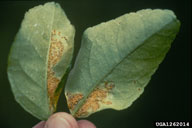
Citrus canker lesions can appear in the mines left by the citrus leafminer pest. Photo by Timothy Schubert, FDACS
- Look at Homeowner Fact Sheet: Citrus Canker for more information.
- Leave the tree in place in your yard and call the Division of Plant Industry at FDACS at 1-888-397-1517 for a free inspection and testing of your citrus trees.
- Consult your local Horticulture Extension Agent for more information and control/removal strategies.
- Proper removal of infected trees is recommended to prevent the spread of citrus canker but is not mandatory.
For more information please see:
Save Our Citrus Website
UF IFAS Gardening Solutions: Citrus
Citrus Culture in the Home Landscape
UF IFAS Extension Online Guide to Citrus Diseases
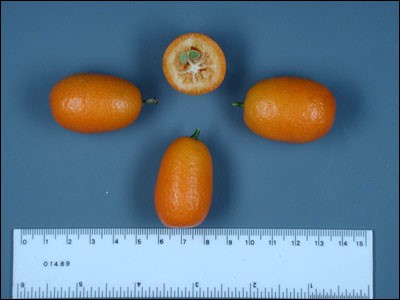
by Mary Salinas | May 5, 2016
The panhandle of Florida is a great place to grow citrus with our plentiful sunshine and sandy soil. But some varieties do better than others. Here are some that thrive in the more northerly climes of Florida:
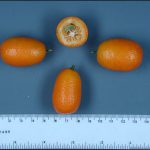
Nagami kumquat. Photo credit: UF/IFAS.
- Satsuma mandarin is cold hardy to 15°F once established. There are a few different available cultivars with fruit ripening October through December. Fruit needs to be picked promptly when ripe.
- Kumquat is cold hardy to 10°F once established. ‘Nagami’ and ‘Meiwa’ are the two common cultivars of the small tart fruits. Fruit matures in fall and winter and holds fairly well on the trees.
- Calamondin is a lesser known variety that bears small fruit that resemble tangerines. The tart fruit is great for jams and chutneys. Fruit is borne all year.
- Some of the sweet oranges that do well in the panhandle are Navel, Hamlin and Parson Brown. They are cold hardy to 14°F once established and are harvested November through January.
- Minneola or Honeybell tangelo is also hardy to 14°F and harvested in January. This is a cross between a Duncan grapefruit and a Darcy tangerine. This bell-shaped fruit is very juicy and sweet. Unlike the other citrus varieties, it needs another citrus nearby for cross-pollination in order to produce an abundant crop.
- Meyer Lemon is the choice to make if you would like to grow lemons in the panhandle. Other lemons may be damaged by our occasional freezes.
Grapefruit and lime can be grown – although unreliably – on the coast with protection from northwestern winter winds. They are much more susceptible to freezes in more northerly panhandle locations.
In order to have the healthiest and most productive trees, learn about how to properly care for citrus and how to recognize and combat the pests and diseases that occur.
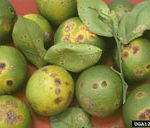
Citrus canker symptoms on leaves, fruit and stem. Photo by Timothy Schubert, FDACS
There are threats to our dooryard and commercial citrus from pests and disease. Only vigilance will help to combat the challenges so that we may continue to grow and enjoy our citrus. What can we do to protect our citrus?
- Report any serious diseases like suspected citrus canker or citrus greening to the Division of Plant Industry by calling toll-free 1-888-397-1517. Inspections and diagnosis are free. Citrus canker has been confirmed in south Santa Rosa County in the past 3 years.
- Purchase citrus trees only from registered nurseries – they may cost a little more but they have gone through an extensive process to remain disease and pest free. That will save you $$ in the long run!
- Don’t bring plants or fruit back into Florida – they may be harboring a pest!
- Citrus trees or fruit cannot move in or out of the State of Florida without a permit. This applies to homeowners as well as to the industry. This rule protects our vital dooryard trees and citrus industry.
For more information please see:
Save Our Citrus Website
UF IFAS Gardening Solutions: Citrus
Citrus Culture in the Home Landscape
UF IFAS Extension Online Guide to Citrus Diseases
Your Florida Dooryard Citrus Guide – Common Pests, Disease and Disorders of Dooryard Citrus
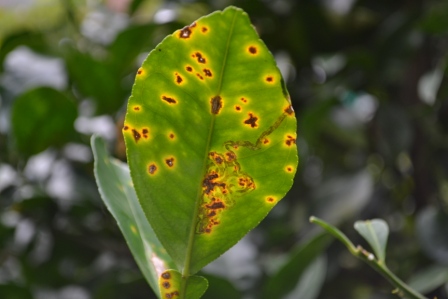
by Blake Thaxton | Nov 25, 2013
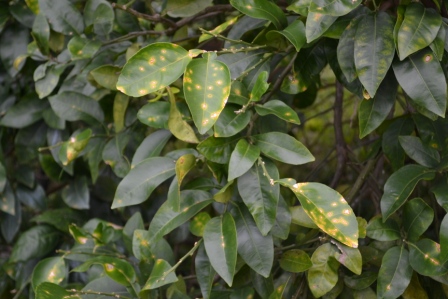
Citrus Canker lesions on leaves. Photo Credit: Beth Bolles, UF IFAS Extension – Escambia County
Authors: Blake Thaxton & Mary Derrick, UF/IFAS Extension – Santa Rosa Co. Mikaela Anderson, FDACS Division of Plant Inspection
Citrus canker is a serious disease of citrus trees that was recently confirmed for the first time in southern Santa Rosa County. Canker is caused by the bacterial pathogen Xanthomonas citri subsp. citri. Citrus canker has been a major pest of citrus in south and central Florida. It is economically damaging to the commercial industry and is also problematic to homeowners because it causes premature fruit drop, discolored fruit, and eventually causes the tree to become unproductive.
Canker was first introduced in 1912 into Florida and was declared eradicated in 1933. The disease was found again in the Tampa area on citrus in 1986. It was declared eradicated in 1994, but once again was found in 1995 in Miami. This time, the disease was not successfully eradicated in part because hurricanes made the disease too widespread to control. Despite its prevalence in south and central Florida, this disease has not been known in the Panhandle. The University of Florida and the Florida Department of Agriculture and Consumer Services’ Division of Plant Industry will be assessing the extent of the disease in Santa Rosa County in the coming months.

Lesions growing through the channels formed by the Citrus Leafminer insect. Photo Credit: Beth Bolles, UF IFAS Extension – Escambia County
How might you know if your citrus is infected by canker? One of the best indicators of canker is the presence of lesions, diseased spots, on the upper and lower surfaces of the leaves. The lesions will be raised and have a rough surface and will be surrounded by yellow halos. Similar lesions may be present on the fruit and stems as well.
[important]If you suspect that your citrus trees may have citrus canker please contact the Division of Plant Industry’s Helpline Center at 1-888-397-1517 before taking any action to reduce accidental spread of this disease. [/important]
before taking any action to reduce accidental spread of this disease. [/important]
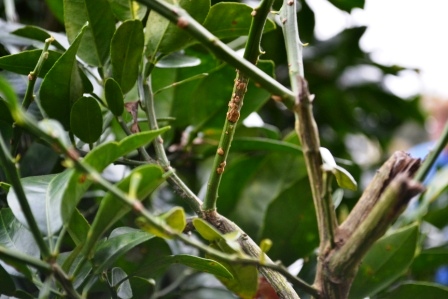
Lesions formed on the stems. Photo Credit: Beth Bolles, UF IFAS Escambia County Extension
The disease is highly contagious to citrus only and spreads rapidly through wind, rain and via people on their hands, clothes, and tools. Do not transport any plant material that shows symptoms of canker. Decontamination practices should be used when going from one citrus tree to the next. Hand washing with soap and water for 20 seconds or more to eliminate bacterium on the skin should be practiced as well as using alcohol-based hand sanitizer. Pruning tools or other tools that come into contact with citrus should be disinfected by a fresh solution of 1 ounce of household bleach to 1 gallon of water. An old or dirty bleach solution is not able to disinfect because the chemical is no longer active.
[warning]Do Not Move a Plant Infected with Citrus Canker. Please Call your local Extension Office for further instructions[/warning]
For more information on citrus canker:
(The University of Florida IFAS Citrus Canker website provides a photo gallery of disease symptoms & information about the disease)















